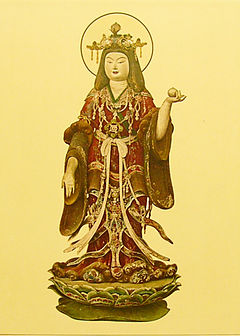Kisshōten
Appearance
| Śrīmahādevī (Buddhism) | |
|---|---|
 | |
| Sanskrit | श्रीमहादेवी Śrīmahādevī |
| Chinese | 吉祥天 (Pinyin: Jíxiáng tiān) |
| Japanese | 吉祥天 or 吉祥天
( romaji: Kichijōten) |
| Korean | 길상천
( Vajrayāna |
Kisshōten (kagome.
When Kisshoutennyo is counted among the seven fukujin[2] and fellow Fukujin Daikoku is regarded in feminine form,[6] all three of the Hindu Tridevi goddesses are represented in the Fukujin, with Daikoku representing Parvati and Benzaiten representing Saraswati.
See also
- Buddhist Tenbu (天部) deities
- Fukujin (福神) deities
- Hinduism in Japan
- Kagome crest
- Kagome lattice
- Kisshō Tennyo (manga)
- Lakshmi
- Star of Lakshmi
- Ashtalakshmi
- Nyoihōju (如意宝珠) wishing gem
- Satkona
- )
References
- ^ a b "Wooden figure of Kichijōten". The British Museum. Retrieved 27 August 2012.
- ^ a b "Butsuzōzui (Illustrated Compendium of Buddhist Images)" (in Japanese). Ehime University Library. 1796. p. (077.jpg). Archived from the original (digital photos) on 10 October 2018. Retrieved 14 May 2016.
- ^ "Kichijoten Japanese Lucky Goddess of Beauty". 10 February 2023. Archived from the original on 10 February 2023. Retrieved 1 March 2023.
{{cite web}}: CS1 maint: bot: original URL status unknown (link) - ^ "Kisshōten (Kichijōten)". Philadelphia Museum of Art. Retrieved 27 August 2012.
- ^ Neighbour-Parent, Mary. "Kichijouten 吉祥天". JAANUS. Atsumi International Scholarship Foundation.
- ^ "Butsuzōzui (Illustrated Compendium of Buddhist Images)" (in Japanese). Ehime University Library. 1796. p. (059.jpg). Archived from the original (digital photos) on 10 October 2018. Retrieved 14 May 2016.
External links
![]() Media related to Kichijouten at Wikimedia Commons
Media related to Kichijouten at Wikimedia Commons
